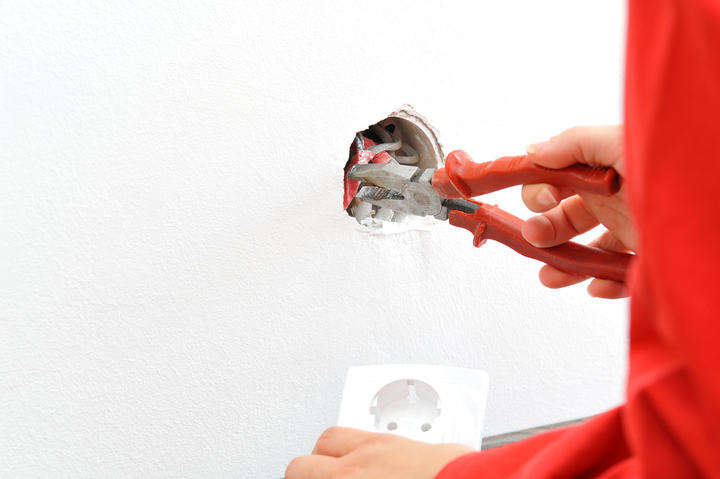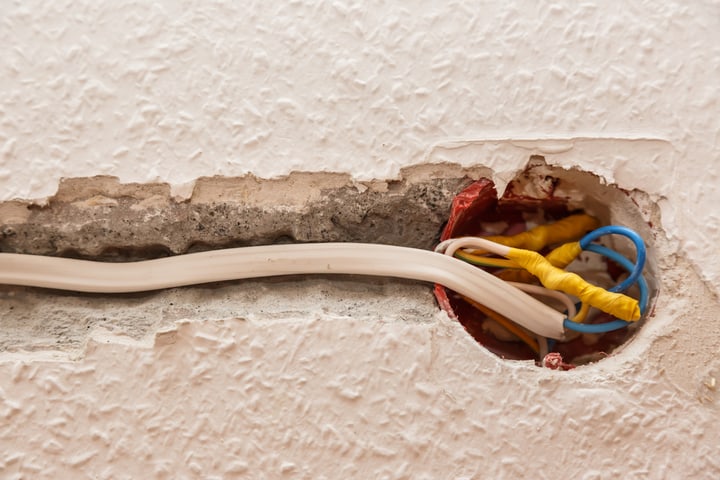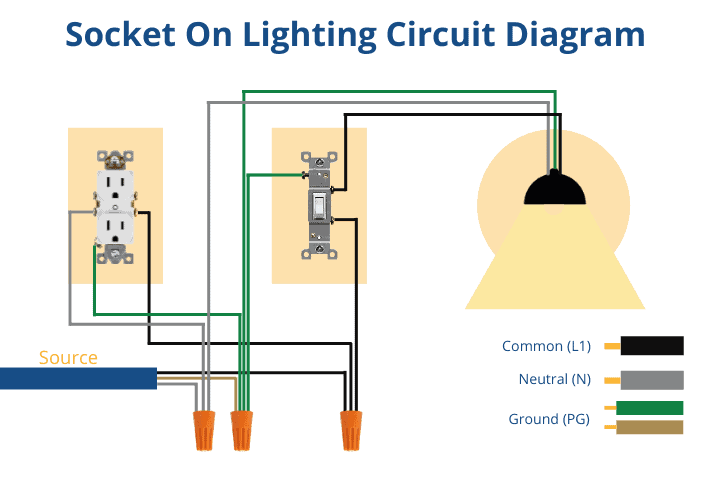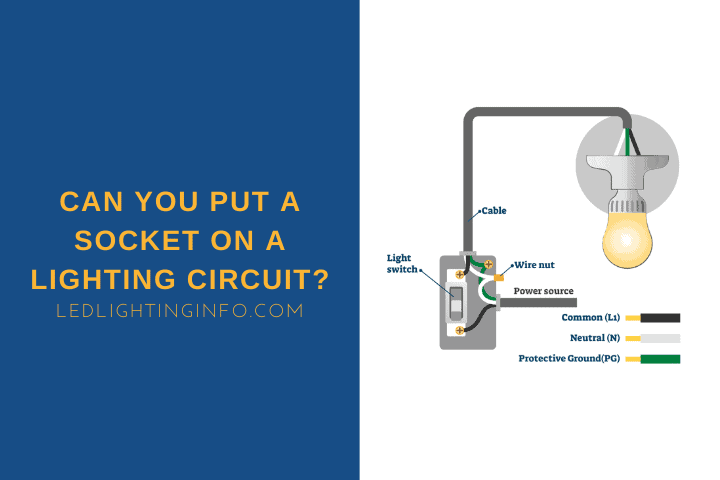Electrical circuits in your home are tailored to the job they need to do.
So you will have a hardwired lighting circuit for all your light fittings, a circuit for your power outlets (sometimes split between different areas of the property), and then dedicated circuits for key high-powered items such as your furnace/boiler.
The problem is when you want to add a new power socket to your home, but it’s not close to the existing wiring for your sockets.
A good example might be adding a power outlet in a closet under a staircase, which has a light but would be an unusual place to have an existing socket nearby.
Feeding the wiring to add it to the socket circuit might be tricky, so can you not just wire the socket onto the lighting circuit close by instead?
Technically, you can wire a socket onto a light circuit, but it is not recommended. There can be problems with overloading the circuit. If you add a socket to a lighting circuit, do it in parallel. Otherwise, the light switch will control the circuit.
Let’s take a look at:
- Whether lights and 13A sockets can exist on the same circuit
- Why you should only wire sockets in parallel
- The main things to consider when wiring a socket with lights
Can Lights And 13A Sockets Be On The Same Circuit?

So, the first question you should always ask before undertaking any electrical job is, is it safe?
And technically, adding a 13A socket to a lighting circuit, providing you follow normal guidance and procedures, is going to be safe.
When you plug something into it, that’s when you’re going to maybe have problems…
It’s not something to make light of, though. Because there are risks with adding a socket onto a lighting circuit that you can’t disregard.
Firstly, lighting circuits will have a different circuit breaker to your socket circuit. In the UK and Europe, that’s normally 5A or 6A, although, in the US, it can be higher at 15A.
If you add a 13A socket to a circuit designed to carry 5A or 6A, you could absolutely overload it.
In North America, where outlets are rated at 15A or 20A, if you add a 20A socket to a 15A lighting circuit, then you’ve got the same issue.
Secondly, there’s the issue of grounding protection. There is some form of trip switch wired into socket circuits in most domestic homes.
In North America these are called a Ground Fault Circuit Interrupter (GFCI), and in the UK and Europe they’re called a Residual Current Device (RCD).
The purpose of these devices is to cut the power to a circuit if there is any electrical flow into a grounded surface so that you aren’t electrocuted due to a fault.
They’re legally required where there is water near to a socket – for example bathrooms, kitchen countertops or outdoors – and it’s estimated they’ve cut down on around 50% of home electrocutions in that time. If you can add a GCFI or RCD to a circuit then it is making it safer.
However, indoor, hardwired lighting circuits are not legally required to have an RCD or GFCI.
So wiring a socket in and then plugging in a device that could develop a fault may not trigger the circuit to cut out.
Basically, a socket circuit is designed to handle a wealth of appliances that are plugged in. Therefore, you should always, where possible, wire a socket into the circuit that was designed for it.
But, if you do put a socket on a lighting circuit, you must be careful with it – never use a cheap imported appliance that wasn’t manufactured under strict safety conditions, and never use an appliance that is broken in any way.
Should I Wire A Socket In Series Or Parallel?

Suppose you cannot wire your socket into the socket circuit, and the lighting circuit is your only option. In that case, there’s then a decision to make about whether you wire it in series or in parallel.
The chances are, if you’re trying to get away with minimal wiring work, you’re actually hoping to just put the socket in series, but that’s actually a horrible idea.
You should still make sure to wire the socket in parallel from the circuit breaker because this helps distribute the current, giving it multiple ways to pass through in the case of an overload.
Putting everything in series means that the current has one path. If your appliance that’s plugged into the socket malfunctions, then there’s no inherent safety backup.
Also, there’s a really practical reason to avoid wiring a socket into a circuit in series with lights – the light switch.
If you wire a socket into a circuit loop with a switch on it, the switch will control the light and the socket.
You’d never be able to use the socket with the light switched off, which can be a real inconvenience and waste of electricity.
Main Watchouts When Wiring Socket With Lights

There are three main things you need to look out for if you decide to wire a socket into a lighting circuit.
Firstly, it’s the issue we’ve already covered with the switches. You need to make sure that you don’t wire a socket into a loop with a switch if you want to control it independently.
Secondly, you should avoid installing a socket on a circuit unprotected by a GFCI or RCD where possible. Though not illegal, it’s recommended due to the number of electrocutions they’ve protected against.
It’s really easy to tell if your circuit breaker is GFCI, as there’ll be a button on it labeled “push here to test,” or on an RCD circuit, it might just say “T” or “Test.”
No button = no protection.
If you add a socket to a non-protected circuit, and something goes wrong with the appliance plugged into the socket, you’re risking electrocution.
Finally, it’s worth noting that different wires are generally used for lighting circuits and power sockets. If you wire a socket into a circuit with the wrong type of wire, you risk not getting the sufficient current needed to ensure the socket works safely.
Generally, in North America, lighting circuits use AWG-14 wiring, while outlet circuits will use the thicker AWG-12 wiring.
AWG-12 is rated for 20A, while AWG-14 can only handle 15A. So, adding a 20A socket to a lighting circuit with AWG-14 wiring isn’t safe.
Same in the UK and Europe – 1mm wiring is sometimes used for lighting circuits, which can only safely handle 8A.
The 1.5mm wiring can handle between 14 and 20A, so I hope you can see the issue here.
Diagram Of Wiring Lights And Outlets On The Same Circuit

This diagram shows how you need to wire an outlet into the lighting circuit to ensure it is always hot – aka not controlled by the switch.
You’ll need to run a new two-wire cable from the fixture box to the new outlet location, with the source hot spliced to run both to the new black wire and the existing black switch loop wire.
The neutral wire is then spliced with the new white wire and then between the switch and the fixture in a pigtail.
Then, the new ground wire is spliced into the existing ground wires in the ceiling box.
Final Words
If you’re really keen to add a new socket to your home, but you can’t easily wire it into the existing socket circuit, then you may be able to add it to a lighting circuit.
But, you’re going to need to make sure that the lighting circuit has the necessary breaker protection and sufficient wiring and power to handle whatever you intend to use the outlet for.
It’s almost always best to wire a socket into the socket circuit, even if it means more work.
It’s safer too.
Have you had problems adding new sockets to your home? Maybe you’ve added a socket to your lighting circuit – how did that go?
Looking for an LED bulb but not sure what type you need?
Check out my free bulb picker and select the right bulb within few clicks.

